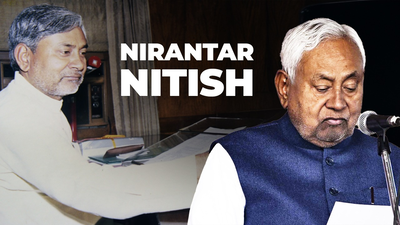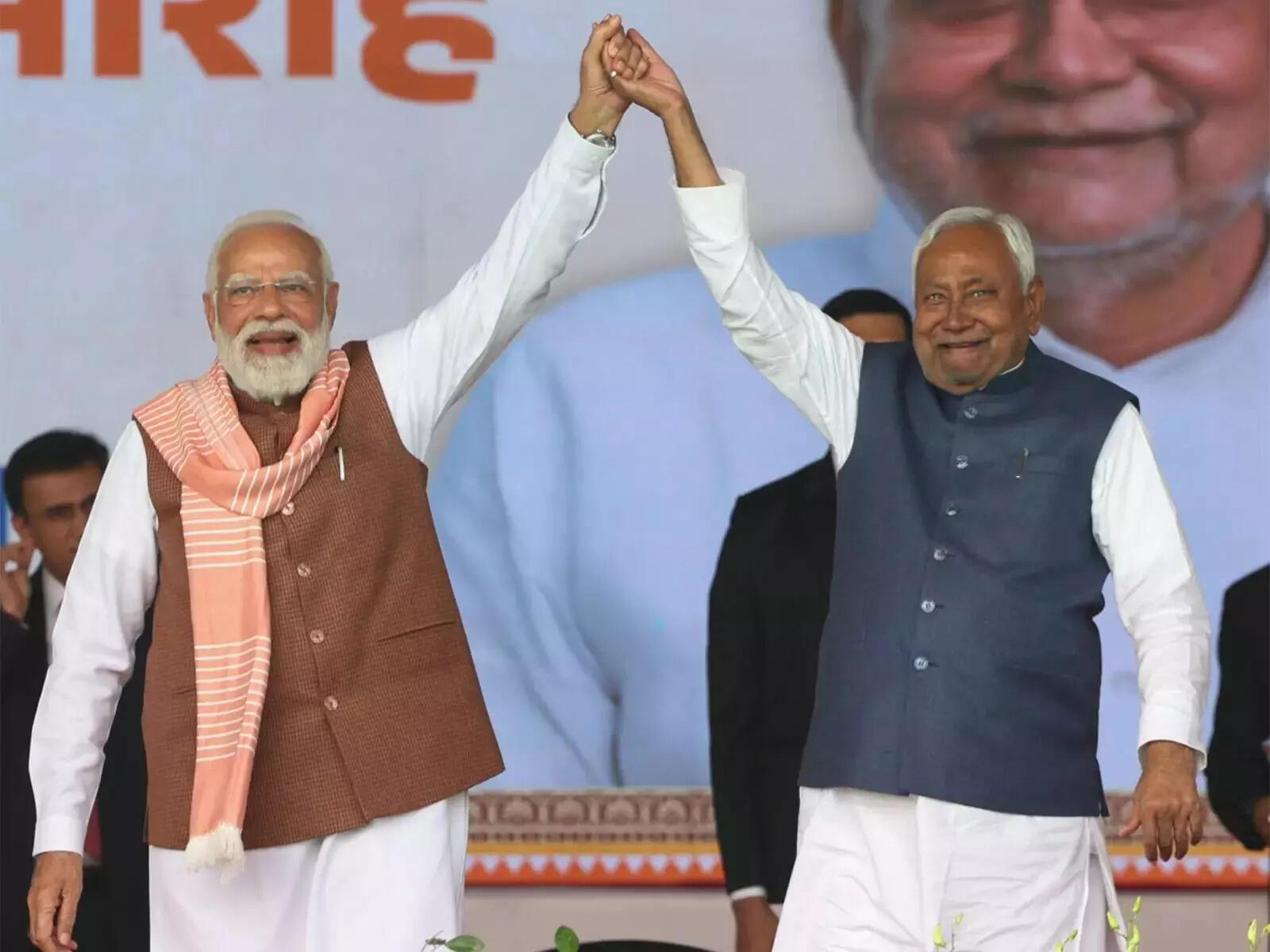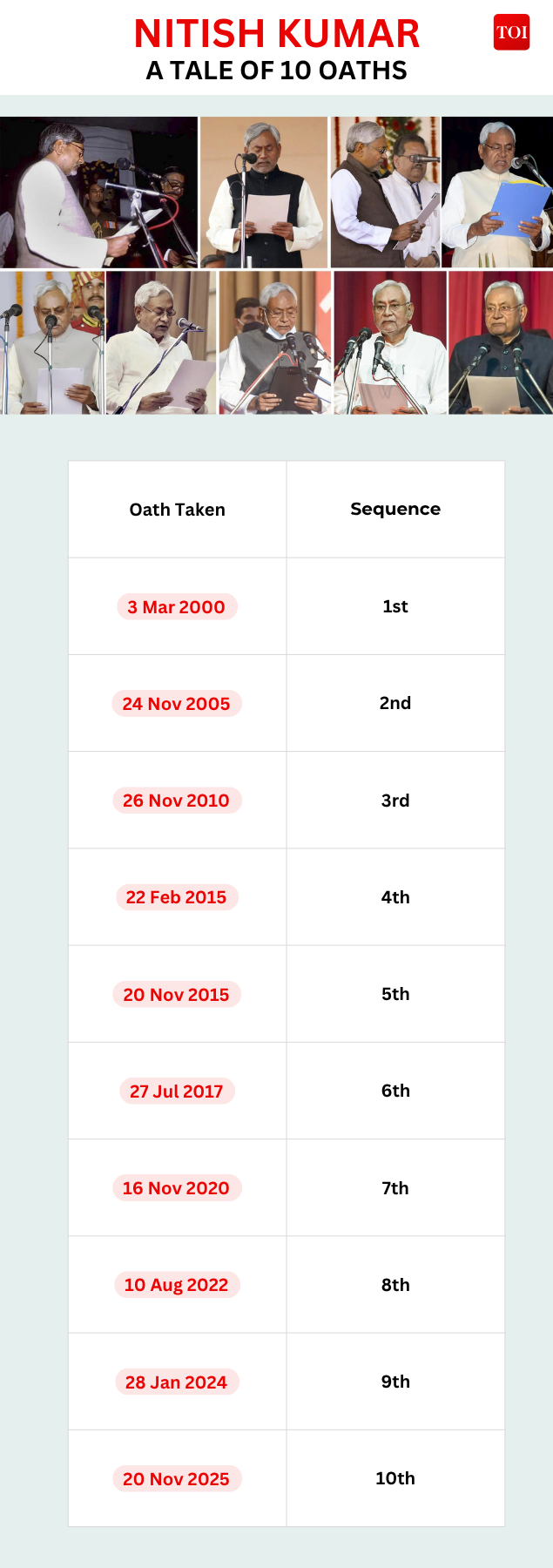
'Nirantar' Nitish Kumar once again takes oath as CM of Bihar.
NEW DELHI: Phir ek baar Nitish Kumar. Bihar, once again, has sealed its political future in the hands of a man who has ruled it for most of the past two decades -- a leader who has mastered the art of survival, reinvention, and political engineering like no one else in modern politics. With a thunderous NDA majority of 202 seats, the state has handed Nitish Kumar his 10th chief ministerial term, an extraordinary milestone he reached on November 20, 2025.The relentless, "nirantar" Nitish Kumar has once again emerged victorious, this time an easy way -- a testament to his reputation as an "all-weather politician". At 74, he continues to wield influence with remarkable ease, comfortably reaffirming his place at the centre of the state’s politics.
Nitish Kumar To Take CM Oath For Record 10th Time At Patna's Gandhi Maidan, PM Modi To Attend
For a politician who has been written off more times than he can count, Nitish Kumar stands today not merely as a survivor but as a phenomenon -- a leader who breaks political arithmetic, escapes anti-incumbency, defies public resentment, and returns to the top regardless of the alliances he breaks or builds.
Whether Nitish Kumar’s image as ‘Sushasan Babu’ -- the leader long associated with development, stability, and restored law and order -- still genuinely resonates, or whether years of political fatigue, policy stagnation, and serial flip-flops have dulled that sheen, is a debate that never quite settles in Bihar.
But what is undeniable is this: despite every doubt, every switch, every storm.
This time, the win is emphatic.This time, the message is unmistakable.This time, even the “Joe Biden of Bihar” label -- about age, fatigue, and diminishing appeal -- has been shattered.Nitish Kumar, with this “lion majority,” has emerged as the most popular face in the state, silencing critics and reaffirming that “Nitish sabke hain.”
From Bakhtiarpur to the top: The man who doesn't lose the chair
Born on March 1, 1951, in Bakhtiarpur, Nitish Kumar began not with political ambition but with electrical engineering. But it was social engineering that became his lifelong calling.
His political roots were shaped in the JP movement, where he was among the thousands jailed during the Emergency in Indira Gandhi's era. He won his first assembly election in 1985 from Harnaut, briefly supported Lalu Prasad Yadav in 1989, and then broke away -- beginning a rivalry that would define Bihar politics for decades.In 1994, Nitish quietly engineered the first major rebellion against Lalu. Fourteen MPs broke away under George Fernandes -- but insiders knew Nitish was “the brain.” The group soon became the Samata Party, marking his decisive ideological shift.
Two years later, he made his first big flip -- aligning with the BJP in 1996. This alliance would form, break, reform, and rupture again and again over the next three decades.He entered the Vajpayee cabinet, holding the railway ministry and other portfolios from 1998–2004. His administrative style, focus on law and order, and reform-mindedness gradually shaped his technocratic image.
His first shot at the CM’s chair came in 2000, but the NDA lacked numbers. His government fell in just seven days.But Nitish was not done. He was only beginning.The era that changed Bihar
In 2005, Nitish Kumar returned -- this time ending Lalu Prasad Yadav's 15-year rule, often dubbed as "jungle raj" by many and inaugurating what many call Bihar’s “reconstruction era.”
His 2010 victory solidified his hold over the state, establishing him as the face of development-based politics. Women-centred welfare -- bicycles, uniforms, prohibition, jobs, and cash transfers — created what scholars call a maternal welfare state. Nitish did this better than almost anyone.One man, many switches
And yet, his political journey is not defined only by governance -- but by U-turns.At least six times since 1999, Nitish has switched between the NDA and the UPA or Mahagathbandhan camps.
This earned him the label “Paltu Kumar”.
- In 2013, he snapped ties with the BJP after Narendra Modi became its PM face -- a move that cost him dearly.
- In 2015, he joined the RJD-Congress Mahagathbandhan and returned as CM with Tejashwi Yadav as deputy.
- In 2017, he walked out overnight, resigned, and came back as NDA CM the same evening — his most dramatic switch ever.
- In 2022, accusing the BJP of trying to break the JD(U), he left again and rejoined the Mahagathbandhan.
- In 2024, he switched back to the BJP-led NDA and reclaimed the chief minister’s post -- a dramatic reversal considering he had just helped stitch together what was touted as India’s one of the grandest-ever opposition alliance, the INDIA bloc, formed explicitly to counter the BJP. Yet, in classic Nitish fashion, he eventually folded the experiment and returned to his old ally.
- And now in 2025, the alliance has delivered its most decisive mandate in decades: 202 seats, with BJP’s 89, JD(U)’s 85, and strong support from Chirag Paswan’s LJP (RV), HAM, and RLM.
In each case, Nitish emerged on the winning side -- not weakened, but strengthened.As Machiavelli wrote: “Whosoever desires constant success must change his conduct with the times.”Few Indian politicians embody that insight better.Defeating the hegemon, again and again
Nitish didn’t just defeat Lalu Prasad Yadav in 2005 -- he defeated the entire idea of invincible caste-based politics in Bihar.In 2025, he did it again.
The Nitish-led NDA stormed past 200 seats, crushing the Tejashwi-led Mahagathbandhan, reducing the RJD to just 25 seats — limiting it to just one-third of what it got in 2020. Nitish’s own JD(U) rose to 85 seats, its highest in a decade.The man from Bakhtiarpur faced zero anti-incumbency. If anything, his long stay in power became an asset.The Nitish model of staying in power
The secret behind Nitish Kumar’s political immortality lies in four fundamentals:1. He never contests Assembly elections
Nitish last contested and won an assembly election in 1985.He contested once more in 1995, won, and then switched to Parliament permanently.Since then, he has always taken the legislative council (MLC) route.His famous line: “I chose to become an MLC by choice… the Upper House is a respectable institution.”Keeps his popular face beyond caste and communal lines.2. He becomes indispensable to every alliance
In 2020, the BJP was bigger (74 seats) - yet gave Nitish the CM chair.In 2022, the RJD was larger (75 seats) - yet made Nitish the CM again.His image is universal: “Nitish sabke hain.”3. Welfare + governance = political immunity
The bicycle scheme, women’s welfare transfers, reservation expansions, prohibition, cash incentives -- Nitish shifted Bihar’s politics from caste solidarity to material empowerment.4. He is the ultimate crisis navigator
Party splits, ideological shifts, electoral losses — he absorbs the shocks better than any contemporary leader.A record-breaking 10th term
In 2025, Nitish Kumar stands on the cusp of an unmatched milestone -- his 10th oath as chief minister. Outside the Northeast, no leader in India has come close to such continuity.
He is also in line to break the record of Sikkim's Pawan Chamling and Odisha's Naveen Patnaik to break the record of longest serving chief minister ever in India.The turbulence, the U-turns, the comebacks -- none of it derailed him.Instead, each twist only confirmed what Bihar has now declared with a historic mandate:No matter the alliance. No matter the arithmetic. No matter the storm. Nitish Kumar remains chief minister. |